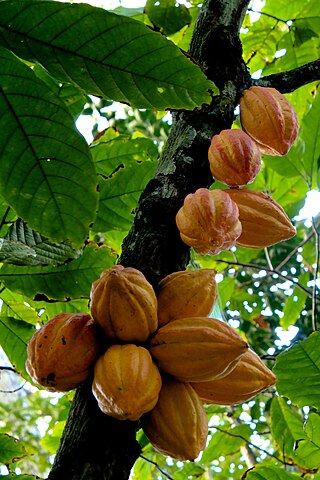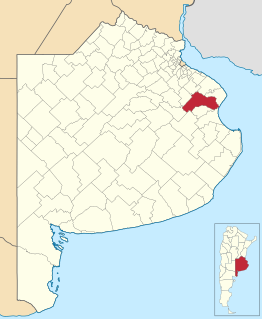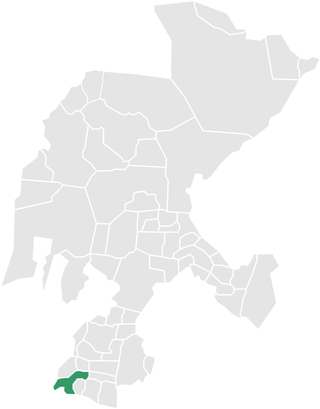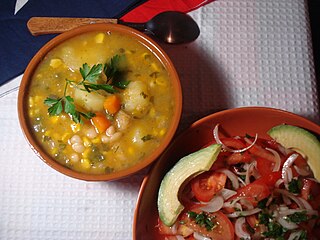
Pochas are a type of Spanish string bean, which originated in the regions of La Rioja and Navarre. [1] [2] The beans are served ripe, rather than dried and re-hydrated.

Pochas are a type of Spanish string bean, which originated in the regions of La Rioja and Navarre. [1] [2] The beans are served ripe, rather than dried and re-hydrated.

Theobroma cacao, also called the cacao tree and the cocoa tree, is a small evergreen tree in the family Malvaceae. Its seeds, cocoa beans, are used to make chocolate liquor, cocoa solids, cocoa butter and chocolate. The largest producer of cocoa beans in 2018 was Ivory Coast, 2.2 million tons. The genus name, Theobroma, is derived from the Greek words θεός (theos), meaning 'god', and βρῶμα (broma), meaning 'food'. The literal meaning is "food of the gods".

Gallo pinto or gallopinto is a traditional dish from Central America. Consisting of rice and beans as a base, gallo pinto has a long history and is important to Nicaraguan and Costa Rican identity and cultures, just as rice and beans variations are equally important in many Latin American cultures as well.

Kimchi-jjigae (김치찌개) or kimchi stew is a jjigae, or stew-like Korean dish, made with kimchi and other ingredients, such as pork or seafood, scallions, onions, and diced dubu. It is one of the most common stews in Korean cuisine.
Pocho is slang in Spanish used in Mexico to refer to Mexican Americans and Mexican emigrants. It is often used pejoratively to describe a Mexican expatriate or a person of Mexican ancestry who lacks fluency or the ability to speak in Spanish and knowledge of Mexican culture. It derives from the Spanish word pocho, used to describe fruit that has become rotten or discolored.

Guillermo Gómez-Peña is a Mexican/Chicano performance artist, writer, activist, and educator. Gómez-Peña has created work in multiple media, including performance art, experimental radio, video, photography and installation art. His fifteen books include essays, experimental poetry, performance scripts, photographs and chronicles in both English, Spanish and Spanglish. He is a founding member of the pioneering art collective Border Arts Workshop/Taller de Arte Fronterizo (1985-1992) and artistic director of the performance art troupe La Pocha Nostra.

Rice and beans, or beans and rice, is a category of dishes from many cultures around the world, whereby the staple foods of rice and beans are combined in some manner. The grain and legume combination provides several important nutrients and many calories, and both foods are widely available. The beans are usually seasoned, while the rice may be plain or seasoned. The two components may be mixed together, separated on the plate, or served separately.

Chascomús is an east central partido of the Province of Buenos Aires in Argentina. Some 110 km (68 mi) south-southeast of the city of Buenos Aires, the district has a total population of around 37,000, some 35,000 of whom live in Chascomús city, the capital of the district.

Zetaquirá is a town and municipality in the Colombian Lengupá Province, part of the department of Boyacá. Zetaquirá is located at 67 kilometres (42 mi) from the department capital Tunja and borders Pesca in the north, Miraflores in the south, in the east Berbeo, San Eduardo and Aquitania and in the west Ramiriquí and Chinavita. The municipality stretches over an area of 262 square kilometres (101 sq mi) on the Altiplano Cundiboyacense at altitudes between 1,875 metres (6,152 ft) and 3,600 metres (11,800 ft).

Turmequé is a town and municipality in the Colombian Department of Boyacá, part of the subregion of the Márquez Province. Turmequé is located at 105 kilometres (65 mi) northeast from the capital Bogotá. The municipality borders Ventaquemada in the west, in the east Úmbita, in the north Nuevo Colón and in the south the municipality Villapinzón of the department of Cundinamarca.
Guananico is a town in the Dominican Republic, situated in the Puerto Plata Province. It has an area of 58.02 square kilometers (22.40 sq mi) and a population of 8,954 of which 3,025 live in the urban part and 5,929 in the rural part. It is the youngest, smallest, and of the smallest population of the eight cities in the province of Puerto Plata.

Teúl de González Ortega Municipality is a town and municipality located in the south of the Mexican state of Zacatecas, between the state capital of Zacatecas and the city of Guadalajara. Unlike most of the rest of the state, its economy has been based on agriculture and livestock, rather than mining, and it is noted for its production of agave and mezcal. The town has been named a Pueblo Mágico to promote a tourism industry.
Tamiahua is a municipality located in the northern part of the state of Veracruz in Mexico. It covers an area of 985.4 km2. It is located at the southern end of the Tamiahua Lagoon. The name may come from the Náhuatl language Tla-mia-hua-c: "In the flowers of maize of the land"; or Huasteco, Tam-yan-ja: "Place of great waters".

The cuisine of Veracruz is the regional cooking centered on the Mexican state that stretches over most of the country's coast on the Gulf of Mexico. Its cooking is characterized by three main influences, indigenous, Spanish and Afro-Cuban, due to its history, which included the arrival of the Spanish and that of slaves from Africa and the Caribbean. These influences have contributed many ingredients to the cooking including native vanilla, corn and seafood, along with rice, spices and tubers. How much the three mix depending on the area of the state, with some areas more heavily favoring one or another. The state has worked to promote its cuisine both in Mexico and abroad as part of its tourism industry.

The cuisine of Chiapas is a style of cooking centered on the Mexican state of the same name. Like the cuisine of rest of the country, it is based on corn with a mix of indigenous and European influences. It distinguishes itself by retaining most of its indigenous heritage, including the use of the chipilín herb in tamales and soups, used nowhere else in Mexico. However, while it does use some chili peppers, including the very hot simojovel, it does not use it as much as other Mexican regional cuisines, preferring slightly sweet seasoning to its main dishes. Large regions of the state are suitable for grazing and the cuisine reflects this with meat, especially beef and the production of cheese. The most important dish is the tamal, with many varieties created through the state as well as dishes such as chanfaina, similar to menudo and sopa de pan. Although it has been promoted by the state of Chiapas for tourism purposes as well as some chefs, it is not as well known as other Mexican cuisine, such as that of neighboring Oaxaca.

Mexico–Portugal relations are the diplomatic relations between Mexico and Portugal. Both nations are members of the Organization of Ibero-American States, Organisation for Economic Co-operation and Development and the United Nations.

Porotos granados is a traditional Chilean countryside stew made mainly of ripe Cranberry beans, maize kernels and squash. Other common ingredients are onions, and herbs such as cumin, basil and oregano. Pumpkin is also used in some recipes. It is considered a summer stew, because that is when the maize and summer squash are harvested in central and southern Chile.
San José, also known as Pizote, is a district of the Upala canton, in the Alajuela province of Costa Rica.

Head of the Class is an American sitcom developed by Amy Pocha and Seth Cohen that was released on the streaming service HBO Max on November 4, 2021. It is based on Rich Eustis and Michael Elias' series of the same name. In December 2021, the series was canceled after one season.
The seed company Pestonjee P. Pocha & Sons at Pune was founded by Pestonjee P. Pocha (1854—1917) in 1884 in a small store at Char Bowri in Poona with two staff members. This was the first indigenous seed company in India. They were followed by Suttons Seeds company in Calcutta in 1912, a branch of the older British seed company. The company grew to 70 employees in 1939 and established its own printing press printing catalogues, calendars atc. They sold seeds for vegetables, flowers, fruits as well as garden tools and equipment. Palekar and Co of Bombay were founded in 1871 but they sold imported seeds. Pestonjee P. Pocha & Sons initially imported seeds from Cape of Good Hope with a climate similar to India.